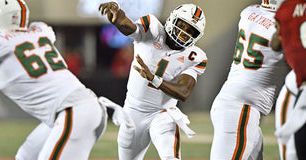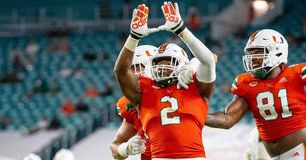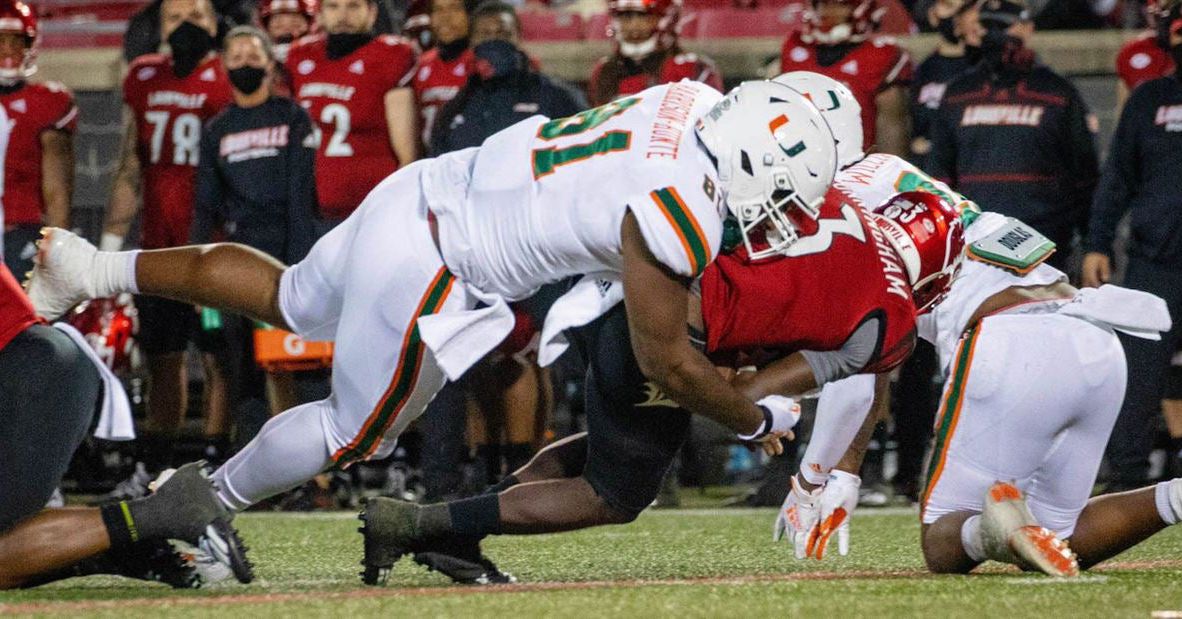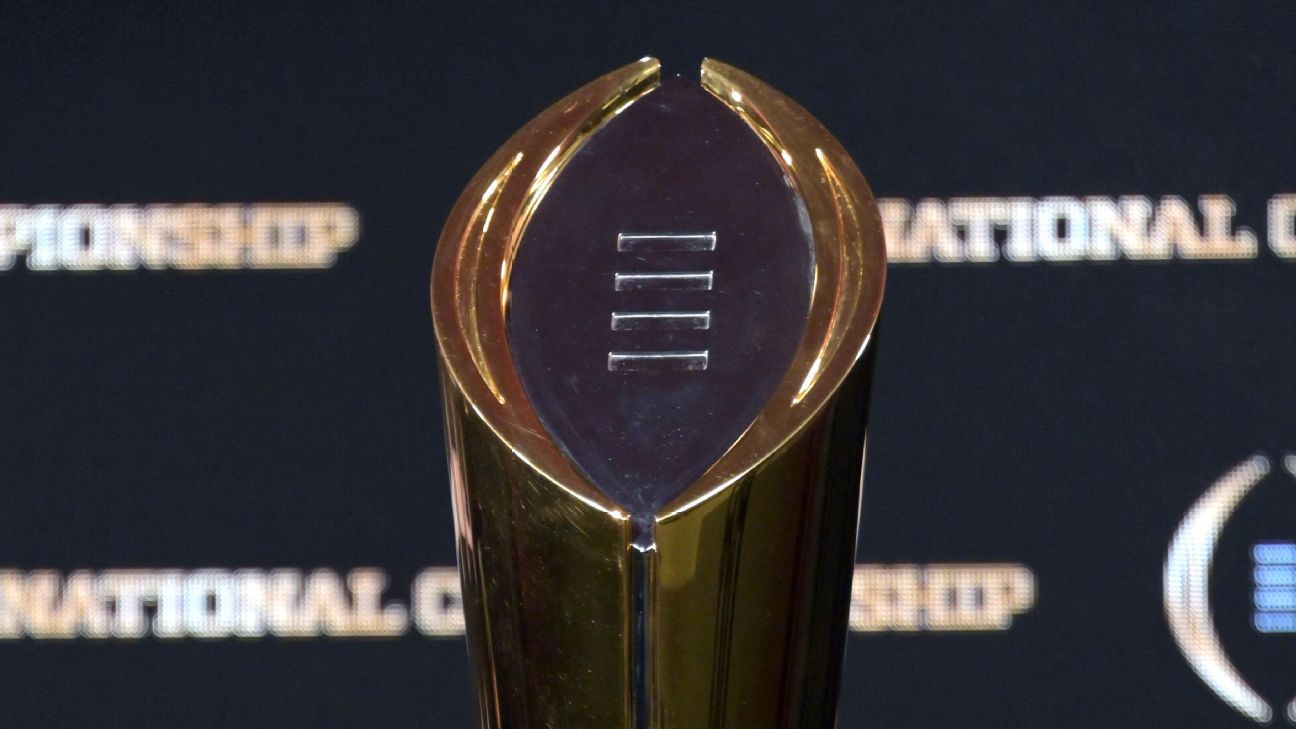▪ Instead of having the winners of each division play in its championship game, the Atlantic Coast Conference this season has ditched the division format and instead will play a Dec. 19 championship game in Charlotte, North Carolina, between the two postseason-eligible teams “with the highest percentage of wins during all regular-season conference competition.”
Because of COVID-19, Notre Dame is playing largely an ACC schedule and is eligible for the ACC Championship Game.
But what happens if multiple teams finish with the second-best record? The ACC has authorized one bizarre scenario in which it could invite a team to the championship game with a worse winning percentage than another. (Details on that in a minute.) Asking and answering:
A). What if COVID forces cancellation of one or two UM games? Would UM still be eligible for the ACC championship?
For any team to be eligible for the game, that team must have played within one total conference game of the average number of conference games played by all conference teams (rounding up/down at .5) during the 2020 season.
For example, if the average number of conference games played in the 2020 season is 9.25, a team would be eligible to participate in the ACC Championship Game, or be considered in a tiebreaker, if that team played eight or more conference games.
B). What happens if teams tied in the loss column have an unequal total number of conference games played?
In that case, head-to-head results will take precedence over win-percentage.
C). What if two teams are tied for the second-best record in the conference?
The tiebreaker order (and there will be a quiz later) would be:
1) Head-to-head competition between the two tied teams.
2. Head-to-head competition versus the team with the best overall win percentage and proceeding through the conference. ...
3. Overall win percentage versus all common conference opponents.
4. Win percentage versus common conference opponents based upon their order of finish (overall conference win percentage) and proceeding through other common conference opponents based upon their conference order of finish.
5. The tied team with the higher ranking by the Team Rating Score metric provided by SportSource Analytics following the conclusion of regular-season games.
And what if none of that breaks the tie? Then a drawing will be conducted by the ACC commissioner or commissioner’s designee.
D). What if three or more teams are tied at the top of the ACC — or the second spot — following the season?
The tiebreakers, in order, would be:
1. Combined head-to-head win percentage among the tied teams.
2. Head-to-head competition versus the team within the conference with the best overall conference win percentage and proceeding through the conference. Multiple ties within the conference will be broken first to last, using the league’s tiebreaker policies.
3. Combined win percentage versus all common conference opponents.
4. Win percentage versus common conference opponents based upon their order of finish (overall conference win percentage) and proceeding through other common conference opponents based upon their conference order of finish.
5. The tied team with the higher ranking by the Team Rating Score metric provided by SportSource Analytics following the conclusion of regular-season games.
Once a team is eliminated from the tie, the tiebreaker procedures restart for the remaining teams. If the three-team (or more) tie can be reduced to two teams, the two-team tiebreaker format will then be applied. All ACC teams hope to play 10 conference games, barring COVID cancellations.
UM is 2-0 in conference, having beaten Louisville and FSU. On tap: at Clemson in Miami’s next game (Oct. 10 at 7:30 p.m. on ABC), Pittsburgh, Virginia, at NC State on a Friday night, at Virginia Tech, Georgia Tech, at Wake Forest and North Carolina.
The Hurricanes and Pittsburgh are the only conference teams with 2-0 records.
The Hurricanes have appeared in only one ACC Championship Game in their history, losing 38-3 to Clemson in 2017.
▪ On WQAM’s Hurricane Hotline this week, Manny Diaz surprisingly said something we had been wondering:
Will the emergence of defensive tackle Jared Harrison-Hunte “light a fire under Jon Ford? [Ford] is in his last year at Miami but sees Hunte [playing well]. That’s what made Miami great in the past; if you’re not doing it, you have someone who can take your job.
“At a couple spots on our team, we’re starting to get competition. Sometimes the difference between first and second line guys doesn’t give you that great competition.” But Diaz said the gap between the first and second team has narrowed at some spots on this Hurricanes roster.
▪ Diaz likes what he saw from his cornerbacks last week, pointing out that FSU’s Tammorion Terry — who has 101 career catches for 1,984 yards — didn’t have a catch on Saturday. “Sometimes, it’s the plays you don’t see, the balls that are not thrown,” Diaz told Joe Zagacki and Don Bailey Jr.
“Terry has caught one ball on us in three years, didn’t catch a ball on us the other night. We had bump and run man coverage denying what they want to do. Those guys are doing a great job at the line of scrimmage, getting their hands [on receivers].”
Per Miami Herald correspondent Daniel Gould, DJ Ivey allowed only one of three passes thrown against him to be caught, for 7 yards. Al Blades Jr. allowed no completions on two targets. Te’Cory Couch wasn’t specifically targeted.
▪ Diaz loves how his coaches are making in-game adjustments. One example, as Diaz explained on WQAM: “Florida State went from a four-down defense [four players with their hands on the ground] to a three down defense, everything different from what D’Eriq [King] had practiced all week and [offensive coordinator Rhett Lashlee] had game planned all week.
“Our staff’s ability to think on their feet quickly and make quick adjustments [is impressive]. It’s not the easiest thing to block a four down front in practice and all of a sudden you’re confronted with a three-man front. It’s hard to remember their defensive line making a play during the game.”
▪ Diaz, on Hotline, said yet another advantage of playing up tempo is the fact that “the more we get a defense tired and worn down, we get a chance to play against their twos and tired ones. The fact we can hit them with [running backs] Cam’Ron Harris and here comes Don Chaney, and here comes Jaylon Knighton.
“Fourth quarter, they’re really worn down and then they have to tackle Robert Burns and that’s no fun at all. They all have a little different running styles. Great job the offensive line is doing in front of them.”
▪ Diaz said receiver Jeremiah Payton — who didn’t play a snap against FSU after missing the Louisville game — is going to be re-incorporated moving forward. “It will be great to get Payton back in the mix; you’ll be seeing him a lot more,” Diaz said. “We really like [the four freshmen] Michael Redding and Keyshawn Smith and Xavier Restrepo and Daz Worsham.”
He said the three older receivers (Mark Pope, Mike Harley, Dee Wiggins) have learned that improved conditioning has allowed them to “push through” any fatigue in UM’s up-tempo offense.



